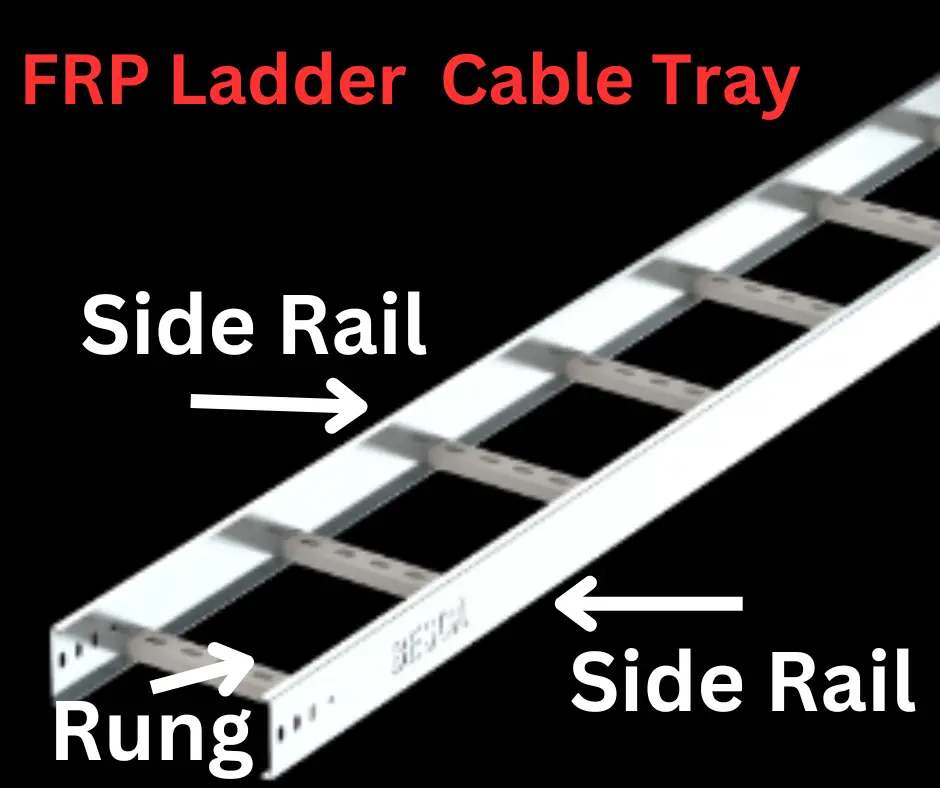FRP ladder type cable tray is made of a polymer matrix reinforced with fibers, such as glass fibers. These types of trays are used to support and organize the cables. Here, FRP is the material of the cable tray, and its full form is fiber-reinforced plastic. It is called a ladder-type tray because its shape resembles a ladder with parallel side rails connected by a series of rungs.
Construction of FRP ladder Cable Tray
You would have seen this type of cable tray in industrial or commercial installations. The shape of the tray is exactly like a ladder. It has side rails on both sides, and sides are supported with rungs. The rungs create a series of openings throughout the tray length—the cables rest on these rungs. The image of the FRP ladder-type cable tray is shown below.

The tray’s specifications are crucial for selecting the desired tray during procurement.
Specifications
| Specifications | Specifications |
| Material | FRP-fiberglass-reinforced polyester |
| Construction | Ladder-type design with side rails and regularly spaced rungs |
| Dimensions | Available in 150mm, 300mm, 450mm, |
| Rung Spacing | 200 mm or 300 mm, may be tailor-made |
| Side Rail Height | Specify the height |
| Load Capacity | The load capacities depend on the width, depth, and thickness of the cable tray. 300mm Width: 60 Kg/linear meter 450mm Width: 75 Kg/linear meter 600mm Width: 90 Kg/linear meter 750mm Width: 120 Kg/linear meter 900mm Width: 150 Kg/linear meter |
| Surface Finish | smooth or textured surface. |
| Color | Available in different colors |
| Permissible deflection under Test | Shall not exceed L/200mms |
| Length of the tray | 2Mtrs/3Mtrs |
Features of FRP ladder Type Cable Tray
The following features of the tray make these FRP trays special for industrial and commercial installations.
- Corrosion Resistance: The trays are highly resistant to corrosion and most suitable for corrosive environments.
- Low Thermal Conductivity: FRP has a high thermal resistance, and it reduces the risk of heat transfer along the cable tray.
- Chemical Resistance: Trays are suitable for use in chemical plants because they resist the chemical attack.
- Non-Conductive: The leakage current flowing through the tray creates electromagnetic interference and causes instruments to malfunction. These trays are non-conductive and best suited for applications where such interference problem occurs.
- Fire Retardant: FRP is fire retardant, and FRP tray does not catch fire in the event of fire.
- Light Weight: FRP is remarkably lighter than metal, and it is easy to handle, transport, and install these trays.
- High Strength-to-Weight Ratio: The FRP trays have a high strength-to-weight ratio.
- UV Resistance: Trays are resistant to ultraviolet (UV) radiation
- Low Maintenance: FRP does not corrode, and it does not require regular maintenance.
- Durable: FRP resists corrosion, chemicals, and environmental factors, and thus, FRP ladder-type cable trays have a long service life.
- Environmentally Friendly: FRP can be recycled, contributing to environmental sustainability.
Applications of FRP ladder Type Cable Tray
The unique features of the tray make them suitable for installation in industrial and commercial installations. They are used in Chemical Plants, Petrochemical plants, Wastewater Treatment Plants, Coastal and Marine Environments, Power Plants, Pharmaceutical Industries, Data Centers, Textile Industries, Renewable Energy Projects, Food and Beverage Industry, Telecommunications, Oil and Gas Industries, Mining Industry.
Conclusion
In conclusion, the FRP ladder-type cable tray has unique features that make it most suitable for cable management in harsh environments. We discussed the specifications and features of the FRP ladder tray, which is helpful in tray selection.